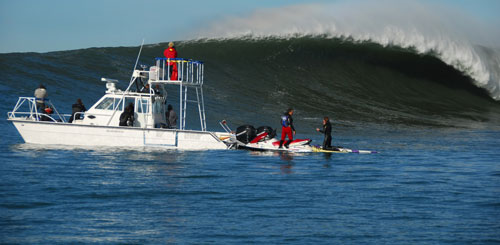Commentary: There Is No Too Slow at Night
Even photographer Robert Brown’s 30-foot photo boat (shown here at Maverciks big-wave surf spot) has radar for nighttime running.
Last night, I work up at 3 a.m.—OK, so technically that’s morning but you get the idea. I stared out the bedroom window at the manmade lagoon in back of the house my family and I are renting this week in Stinson Beach, Calif. It was so dark that I couldn’t tell where the dock ended and the water began.
Unable to get back to sleep, I walked to the front of the house and stared at the natural lagoon. It was so dark that I couldn’t see any of the small islands where, the morning before, I’d kayaked with my kids and a few close friends to watch hundreds of seals.
Still not quite ready for another shot at sleep, I walked to the ocean—it’s about 300 yards, give or take, from our doorstep. Thanks to white sands of Stinson, I could see where the beach ended and the ocean began, but beyond that the ocean was as black and impenetrable as the starless, cloudy night sky.
I went back to bed and fell asleep thinking about the darkness. I woke up about three hours later ago thinking about it, too. And it occurred me that the absolute last place I’d want to be at night is in a high-performance boat. And if I absolutely had to, I’d want to be running at not much more than idle speed.
How treacherous is running after dark? Treacherous enough for commercial vessels of all kinds, from the 30-foot photo boat owned by go-fast boat photographer Robert Brown to 1,500-foot super tankers to be equipped with systems such as radar to help keep them safe at night. Ask a professional skipper if he’d willingly run at night without those systems.
So what do we, who are lucky if our boats have GPS systems, know that someone whose living depends on his survival on the water does not? Nothing.
Here’s what we do know: There is no “too slow” on the water after dark. There is only “too fast.”
Navigation and running lights are essential “see and be seen” equipment. But to see and be seen, you have to do so “in time,” and the faster you go, the less time you have. To most of us, 30 mph on the water seems really slow. But two oncoming boats running 30 mph have a combined closing—and collision—speed of 60 mph. Not slow at all, especially in something without air bags and shoulder restraints.
I once spun out twice in a blizzard in Colorado on my way to a friend’s house. When I got there, I told him about it. I finished my story with, “I was only going 25 mph!” He shook his head and said “Guess that 25 mph was too fast, huh?” I got the message.
Most of you don’t run your boats at night—there’s too much else to do—and if you did I know you’d proceed with the obsessive caution it demands. But every season, we lose a few of our own at night and we wring our hands. And after every nighttime tragedy, someone invariably says something like, “He wasn’t even going that fast” or “He knew the water.” And like my friend in Colorado, I shake my head.
Because there is no too slow on the water at night. There is only too fast.


